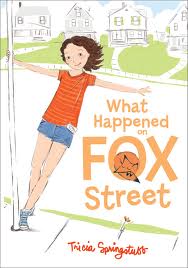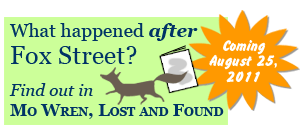Tricia Springstubb has been writing for over thirty years. She lives in Cleveland Heights, Ohio with her husband and two funny cats, Habibi and Billy. She has three grown daughters and she’s an active
SCBWI member. As a matter of fact, she’ll be giving two workshops this September at the
Northern Ohio SCBWI Conference. She writes in the mornings then bikes or swims afterword to think about what comes next. I’m thrilled she agreed to stop by and let us have a peek into her writing life.
Last year, she released What Happened on Fox Street, (Balzer & Bray, 2010) which we’ll talk about in part I of our interview and Part II of our interview will follow on August 15 and coincide close to the release of Mo Wren Lost and Found (Balzer & Bray, Aug 23, 2011), the follow-up to What Happened on Fox Street. Welcome, Tricia.
Why and when did you decide to be a writer? Can you also take us back a few years and share your path to publication?
Long before I discovered I was a writer, I knew I was a reader. As a child I never paid any attention to who wrote the stories I loved—I’m not even sure I understood that a human hand was involved. For me books just sprang up, perfect and astonishing as a mushroom after the rain. I’m a self-taught writer. I learned much of what I know through osmosis; all those words, sentences and paragraphs I read seeped inside me. Many years later, when I tried to tell my own stories, I had a pretty good sense of how to go about it, though I still learn with every book I write.
I’ve always written for both adults and kids, and this is how I got my very first novel published: I’d had a short story in Redbook, and my by-line said I also wrote for children. A young editor from Little, Brown called me up, said she’d liked my story, and asked it I had anything full length. I told her wow, yes—and began to write it the minute I hung up. It was luck supreme—she was a dream editor, generous and patient and wise. She saw me through many fumbles and mistakes and launched my career.
What was the inspiration behind What Happened on Fox Street? Did the plot or characters come first?
Fox Street began with a real incident here on Cleveland’s west side. Some developers, with the support of the mayor, made a bid to buy a small, blue collar neighborhood and replaced it with high-end condos and retail. This neighborhood was on the edge of a glorious metropark. To the surprise of the developers but no one else, the residents fought back. I followed the battle in the media, and recognized a terrific David and Goliath story. Because I love my own neighborhood so much, it was easy to put myself in the shoes of a child living there.
But the book was hard to write—Lord knows how many times I revised it. I couldn’t find the true heart of the story. Meanwhile, I was working in an urban public library where every day I saw children shouldering responsibilities beyond their years. They were so resilient, so heroic! Thinking about their lives led me to Mo, and once I had her, the writing took off.
After reading What Happened on Fox Street (which I LOVED), I really felt like I lived on Fox Street with Mo (protagonist) and her family, how do you go about creating a strong sense of place in your stories?
My family lives on a wonderful street—our three girls grew up here, running from yard to yard, walking to school. Their greatest nightmare would have been moving away. I wanted to write a story where the setting was so real and vivid it was a character in itself. It was so much fun to see old Fox Street through Mo’s eyes, so that weeds growing out of a dilapidated gutter show how much Mother Nature loves a house, and a beer bottle collection becomes a thing of beauty. The sense of place grew out of love’s ability to transform anything, and that permeates the story.
There’s a wonderful cast of characters to support Mo Wren, can you talk a little about how you developed the secondary characters, each one is authentic and distinct? Through the story, we learn what they want and how it ties into the overall plot. Did this occur through outlining or evolve through the revision process? And what do you find most challenging, writing the first draft or revising?
Oh those Baggott boys! I’m going to miss them so much. Don’t we all know mayhem experts like them? The only minor character who’s based on a real person is Mrs. Petrone. When my husband and I were first married, we lived in a small town where all us women got our hair cut in a neighbor’s kitchen. It was the social center. I named my character after one of my favorite children’s librarians here in Cleveland–she was a first reader of Fox Street.
Once a book is finished, it’s almost impossible for me to say how certain parts came to be, but I can assure you I never outline, much as I wish I could. Instead I give myself permission to write sprawling, really ghastly first drafts, and then the revising begins.
I love to revise. Crafting plot is torture for me. Torture! Once I have a plot that works (more or less), I go back and find all the nuances and connections I missed while I was banging my head on the desk. I get to make everything richer, smoother, funnier, and I fine tune the voice. I work a lot on language, which I really enjoy. I call it crawling inside the Cave of Revision.
Mo Wren believes a fox lives on Fox street but no one has seen a fox on Fox street, where did this idea stream from? And when did you know how important it would become to Mo and who “it” truly represented?
Everyone asks me where the fox came from—if only I could say. She was one of those gifts a writer receives now and then. When I was working on the book, I’d never seen a real fox. I watched videos so I could describe her! After the book was finished, but before it was sold, my husband and I were driving through the Adirondacks at night, when he suddenly cried, “What’s that?” And we got a glimpse of a beautiful creature disappearing into the woods. Another gift.
There’s a secret in What Happened on Fox Street, how important are secrets in stories? Did you have to do a lot of brainstorming to figure out what the secret would be in this story? Or did you know from the inception of the book?
The secret was there all along, though at first it was too obvious. My editor told me that everyone in her office figured it out right away. So I had to make it more secret-y. And then I had to figure out why it had stayed a secret all those years, up until the summer of the story. I do think every good story has at least one secret. Right now I’m working on a new middle grade novel that has lots of them.
In the coming weeks,
Austin SCBWI is hosting a critique workshop, do you belong to a critique group? If so, how important is that to your writing?
I belong to a critique group and love it immensely. Writing is such a solitary business! We all need support, at least one other person with whom we exchange work, and whose opinions we trust. My group just keeps getting better and better—in the last couple of years we’ve all had substantial success, and I’m sure that’s at least partly due to the motivation we give one another, as well as the critiques. Cleveland has a small-town, we’re-all-in-this-together feel—writers reach out to one another.
Tell us 3 things you can’t live without.
Books, it goes without saying. Otherwise, I couldn’t live without coffee, phone calls from my daughters, natural light, my library card, my husband’s sense of humor, e-mail, my girlfriends, good bread—wait, is that more than three? I have always been greedy.
Tell us 3 things you wish were never invented.
Now that’s a good one! I guess it’s not inventions that bother me so much as the way we sometimes treat one another. I could surely do without closed-mindedness, bullying, and revenge.
Thanks, Tricia!!!!
Giveaway!
Enter for a chance to win an autographed copy of What Happened on Fox Street. Comment on this post and supply your email address (format: carmen at carmenoliver dot com). Deadline is July 29th, 2011. Giveaway is open to U.S. – Canada readers. Author-sponsored. Good luck!
Don’t forget to come back and see us for Part II of our interview on August 15th, 2011 when Tricia and I talk about Mo Wren: Lost and Found.







